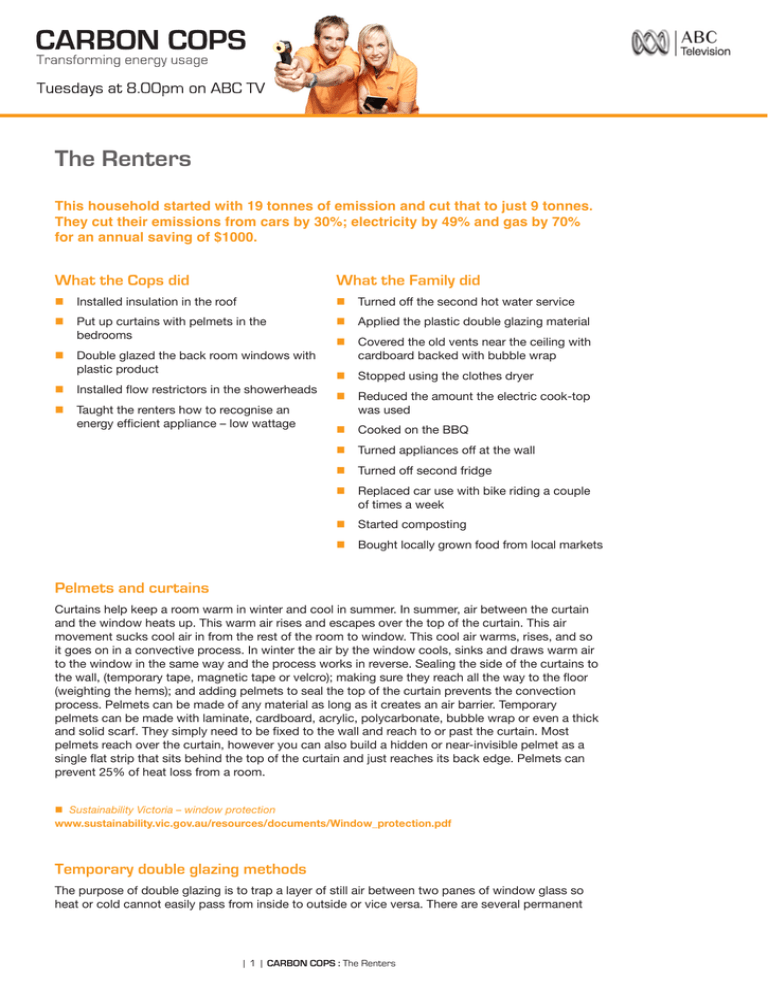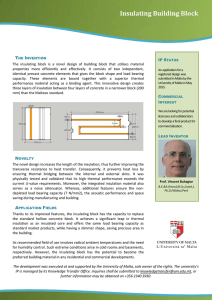The Renters
advertisement

The Renters This household started with 19 tonnes of emission and cut that to just 9 tonnes. They cut their emissions from cars by 30%; electricity by 49% and gas by 70% for an annual saving of $1000. What the Cops did What the Family did nn Installed insulation in the roof nn Turned off the second hot water service nn Put up curtains with pelmets in the bedrooms nn Applied the plastic double glazing material nn Double glazed the back room windows with plastic product nn Installed flow restrictors in the showerheads nn Taught the renters how to recognise an energy efficient appliance – low wattage nn Covered the old vents near the ceiling with cardboard backed with bubble wrap nn Stopped using the clothes dryer nn Reduced the amount the electric cook-top was used nn Cooked on the BBQ nn Turned appliances off at the wall nn Turned off second fridge nn Replaced car use with bike riding a couple of times a week nn Started composting nn Bought locally grown food from local markets Pelmets and curtains Curtains help keep a room warm in winter and cool in summer. In summer, air between the curtain and the window heats up. This warm air rises and escapes over the top of the curtain. This air movement sucks cool air in from the rest of the room to window. This cool air warms, rises, and so it goes on in a convective process. In winter the air by the window cools, sinks and draws warm air to the window in the same way and the process works in reverse. Sealing the side of the curtains to the wall, (temporary tape, magnetic tape or velcro); making sure they reach all the way to the floor (weighting the hems); and adding pelmets to seal the top of the curtain prevents the convection process. Pelmets can be made of any material as long as it creates an air barrier. Temporary pelmets can be made with laminate, cardboard, acrylic, polycarbonate, bubble wrap or even a thick and solid scarf. They simply need to be fixed to the wall and reach to or past the curtain. Most pelmets reach over the curtain, however you can also build a hidden or near-invisible pelmet as a single flat strip that sits behind the top of the curtain and just reaches its back edge. Pelmets can prevent 25% of heat loss from a room. nn Sustainability Victoria – window protection www.sustainability.vic.gov.au/resources/documents/Window_protection.pdf Temporary double glazing methods The purpose of double glazing is to trap a layer of still air between two panes of window glass so heat or cold cannot easily pass from inside to outside or vice versa. There are several permanent | 1 | Carbon Cops : The Renters methods of double-glazing, but two simple temporary and low-cost methods of double glazing are plastic shrink-wrap and bubble wrap. The Carbon Cops installed a temporary glazing called Clear Comfort. This is a sheet of heatshrink plastic. It can be installed with permanent or temporary tape. The sheet is cut to size, taped in place, and then shrunk with a hair dryer until the sheet is taut. Bubble wrap also is readily available new or used. It contains still air trapped in many little bubbles against a plastic sheet. Place it so that the bubbles are against the glass and the flat side is facing away from the window, to create that sealed layer of still air against the glass. Tape it in place on all sides to form a seal. nn Clear Comfort www.clearcomfort.com.au Insulation Insulation is the best way to increase thermal comfort in a home in most Australian climates. There are several kinds of insulation, made of different materials. Regardless of what they’re made of, their effect can be easily compared by the R-value. The R-value is a measure of how much insulation resists heat transfer. The higher the R-value, the longer it takes for heat to cross the insulation barrier. The R- value depends on the thickness of the insulation as well as the material it’s made of. The higher the R-Value the better. The R-value is measured in metres squared per degree of temperature difference (between the two sides of the insulation) per watt of heat flow across the material. The polyester batts installed in this household’s ceiling had an R-value of 3.5 and were 43 centimetres thick. Quick facts on insulation: nn Insulation is the single most effective item you can add to your home to improve its energy efficiency. nn Installing or topping up insulation in ceilings can save a household over one tonne of carbon each year. nn For every square metre of floor space, an uninsulated house one needs 130W of heating. Ceiling insulation reduces the power needed for heating to 100W per square metre, saving almost a quarter of the power. nn A well insulated, energy efficient home will keep your home up to 10ºC cooler in summer and 5ºC warmer in winter. nn Insulating a home can save 45-55% of heating and cooling energy nn Uninsulated ceilings, walls and floors can account for 70% of total heat loss from a home. nn Your Home technical manual on insulation www.greenhouse.gov.au/yourhome/technical/fs16a.htm nn Sustainability Victoria on insulation www.sustainability.vic.gov.au/www/html/1973-energy-saving-fact-sheets.asp Thermal mass There’s a big difference in temperatures in this house between the old section and the new extension. The old section is built with solid brick walls that have a much greater thermal mass than the thin walls of the extension. Thermal mass refers to the amount of material present that is able to absorb and retain heat. Stone, brick, concrete, earth, sand and water | 2 | Carbon Cops : The Renters are all substances that tend to provide high thermal mass. In general, houses in hot climates are better with less thermal mass so they can cool down more quickly overnight. Houses in regions where the temperature goes through big daily variations are better with more thermal mass, to slow the temperature exchange down. Houses in cool climates can benefit from additional thermal mass to maintain warmer conditions inside overnight, but this can also mean they take longer to warm up. nn Your Home – thermal mass www.greenhouse.gov.au/yourhome/technical/fs17.htm nn Sustainability Victoria – thermal mass www.sustainability.vic.gov.au/resources/documents/Thermal_mass.pdf Vent covers and draught proofing Many houses have wall vents. These were essential when our lighting and heating came from gas lamps and heaters that weren’t vented outside. Now there is no need for them, indeed, they are the first thing a low-budget draughtproofer should cover up. Card and paper backed by bubble-wrap works well. These can easily be stuck on and removed later. nn Sustainability Victoria – air movement www.sustainability.vic.gov.au/resources/documents/Air_movement.pdf Water flow restrictors While there are several different kinds of water-efficient shower heads available, a simple and low-cost solution is to install a flow regulator or restrictor inside the existing showerhead connector. This converts any showerhead to low water use for minimal expense. nn Water ratings and water efficiency www.waterrating.gov.au/consumers/index.html Cheap cooling through ventilation To keep a house cool it should be shut up once the temperature outside starts warming up in the morning. Curtains pulled, windows and doors closed. In the evening, as soon as the temperature drops below the temperature inside the house can be opened up to lose any extra heat it’s gained. In winter the reverse applies. Plastic products Most modern plastics are made from petrochemicals. A surprising number of our common household substances and objects are also made with petroleum and its derivatives. These can include cleaning products, personal care products, aerosols, pesticides and garden chemicals. It also includes the foams and coverings of most upholstered furniture. Around 4% of the world’s feedstock of oil and gas is used to make plastics and the bulk of the world’s oil is used for petrol in cars and heating our homes and offices. Using plastics products - through lightweighting, insulation and recycling helps save energy and oil. In the future, oil will become more expensive. Using products that have a low carbon footprint and save energy will be very important. Quick facts about plastic: nn 40% of the plastic used in Australia goes into packaging. | 3 | Carbon Cops : The Renters nn In 2005, Australians used 3.92 billion plastic bags. This has fallen from around 6 billion used in 2002 nn Take a reusable green bag to collect your takeaway. If everyone in Australia did this it would save more than one and a half billion plastic bags, or more than twelve thousand tonnes of plastic each year. Find more plastic bag facts at Clean Up Australia: www.cleanup.com.au/au/Campaigns/plastic-bag-facts.html Food production and food miles Freight in Australia has increased more than 60% since 1990. On average, the emissions from freight add up to 2.2 tonnes of emissions per person per year. Food miles is the term for the emissions generated by transport. Buying local cuts down food miles. Freight transport methods and how they rate per tonne-km, from lowest to highest: 1) Ship 2) Rail and articulated trucks (which have improved in efficiency through better technology) 3) Light trucks and freight vehicles (which have a low carrying capacity) 4) Air freight, which is more than a hundred and twenty times the emissions of carrying by ship. nn Most recent freight statistics and factors from the Australian Greenhouse Office www.greenhouse.gov.au/inventory/2004/trends.html © ABC Copyright 2007 | 4 | Carbon Cops : The Renters



